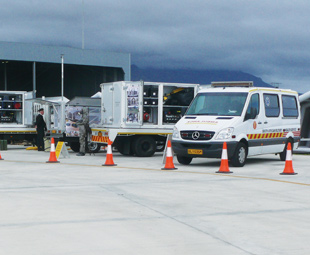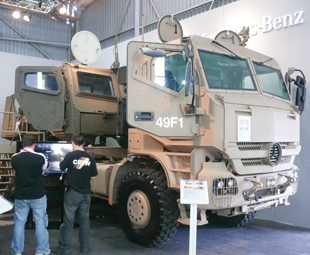War and peace: Mercedes-Benz shows its clout

Military and other specialised vehicle manufacturers, notably Mercedes-Benz SA, pulled out all the stops to impress armament, civil defence buyers and the international media in Cape Town recently. However, it was the air displays at Ysterplaat Air Force base that wooed the crowds.
Cape Town’s Ysterplaat Air Force Base hosted its last Africa Aerospace and Defence show last month and as usual, it attracted thousands of fun and sun-seeking Capetonians and visitors who came out to see the ground and air displays of Rooivalk assault helicopters, the aerobatic Silver Falcons team and the supersonic Griffon fighter jets.
With the South African Defence Force and SA Police Services expected to procure some 4 000 ground vehicles in the next year or two, the serious side was in and around the hangers. It was here that manufacturers displayed specialised vehicles for military, police, civil defence, medical, security and other applications – from armoured Landrovers for VIPs (and corrupt politicians?) to inflatable surgery tents and trailers fitted with water purification plants.
Today, approximately 150 000 Mercedes-Benz-brand military vehicles are being deployed around the world by about 80 different armed forces and to show its clout in this field, Mercedes-Benz South Africa (MBSA) flew a small number of Johannesburg transport journalists to join the international media at a preview of the event.
We learned that in the military sense too, Mercedes-Benz is the world’s only manufacturer to cover all payload categories without exception, from 500 kg through to 110 tons – from the G-Class, the Vito and Sprinter vans, the Unimog and the new Zetros, right through to the two-, three- and four-axled heavy Axor and Actros trucks.
The Mercedes-Benz ranges of commercial vehicles, with special military equipment, combine superb off-road capability with a fording depth of more than 1 000 mm, notwithstanding payload. What’s more, the technology at the heart of Mercedes-Benz all-wheel-drive vehicles provides a climbing ability of up to 80% and, in the case of the Unimog, a full 100% (based on 45 degrees climbing ability being 100%).
 Low cab design enables the 4×4 and 6×6 vehicles to be air-lifted in transport aircraft such as the Hercules C 130 or the Transall C 160 with minimum preparation. Rail transportability is assured as the vehicles comply with the international loading gauge. Other military standards and technical specifications met include all-wheel-drive with single tyres, ballistic protection, blackout lighting system, roof hatch, tyre pressure control, and other features.
Low cab design enables the 4×4 and 6×6 vehicles to be air-lifted in transport aircraft such as the Hercules C 130 or the Transall C 160 with minimum preparation. Rail transportability is assured as the vehicles comply with the international loading gauge. Other military standards and technical specifications met include all-wheel-drive with single tyres, ballistic protection, blackout lighting system, roof hatch, tyre pressure control, and other features.
At Ysterplaat, MBSA’s military division, headed by Dr Harry Teifel, presented a selection of these vehicles. An obvious exhibit was the Unimog 5000 model, representing a range that has the greatest off-road capability in the world in permissible gross vehicle weight classes of between 7,5 and 14,1 tons.
New to SA is the next-generation all-wheel-drive Zetros, a conventional-type truck, which is characterised by its “normal control” configuration (cab located behind the engine). It is targeted at countries where safe and hospitable roads are few and far between – or, for example, relief assignments or military operations such as peacekeeping missions in Africa. The Zetros is available with a 6-cylinder 240 kW engine.
There was considerable interest in the star exhibit – an Actros 3344A in a 6×6 configuration with a ‘SHARCC’ (Southern Hemisphere armoured cab concept) cab. This cab is designed to conform to a ballistic level 1 and a mine level 3a/3b, with no Improvised Explosive Device (IED) protection.
According to Teifel, this configuration is geared towards situations typical in Africa and South America, where close-range and small artillery exchanges can occur – but mines remain a bigger threat, especially on untarred roads. The cab is at a concept-level at this stage, with the testing and certification in Europe not having being completed yet.
MBSA also featured the “Big Daddy” cab, suitable for the Actros 8×8 configuration, for protection in a load-carrying military vehicle. It features a welded armoured steel cab offering ballistic, mine and IED protection. Composite panels are used for enhanced ballistic protection.
This cab offers protection to two crew-members and ample storage. It has undergone extensive testing in the process of certification, including 50 kg of TNT placed one metre away from the driver’s door. All that was added for the show was a fresh layer of paint.
Like its commercial counterpart, the military division is also offering the military a complete range of fleet financing and fleet management services, including Fleetboard, Charterway and driver training.
There were several other armoured vehicle manufacturers, including MAN and Denel, which launched the new Casspir Mk IV, and the Paramount Group, which revealed the Mbombe, a “revolutionary” new six-wheeled armoured fighting vehicle design for protection against both IEDs and mines, and which defeats 50 kg of TNT at five metres.
Then, among the record 300 exhibitors from all over the world, there were armaments manufacturers who used every type of vehicle on which to mount their armaments. Ever seen a VW bakkie fitted with a jammer to jam all radars? We’ve got the picture.
The AAD show will move back to Pretoria in 2012.
Published by
Focus on Transport
focusmagsa



 Big news from FOCUS on Transport + Logist
Big news from FOCUS on Transport + Logist


 !
Starting 1 April, every
!
Starting 1 April, every


 FUSO: Driving the Future of Mobile Healthc
FUSO: Driving the Future of Mobile Healthc



 A brand
A brand




 Wondering about the maximum legal load for a
Wondering about the maximum legal load for a 
 The MAN hTGX powered by a hydrogen combus
The MAN hTGX powered by a hydrogen combus

 Exciting News for South African Operators
Exciting News for South African Operators


